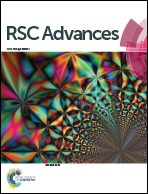Tunable blue-green-emitting Ca3Si2O4N2:Ce3+, Eu2+ phosphor with energy transfer for light-emitting diodes
Abstract
A series of Ce3+, Eu2+ codoped Ca3Si2O4N2 phosphors have been synthesized by traditional solid state reactions, and the crystal structures and luminescence properties were investigated in detail. Rietveld structure refinement indicates that Ca3Si2O4N2 crystallizes in a cubic unit cell with space group Pa![[3 with combining macron]](https://www.rsc.org/images/entities/char_0033_0304.gif) (205) and lattice constant a = 15.0712 Å. Tunable blue-green emitting Ca3Si2O4N2:Ce3+, Eu2+ phosphors have been obtained by codoping Ce3+ and Eu2+ into the host and varying their relative ratios. Compared with the Eu2+ ion singly doped phosphor, the codoped phosphors have wider absorption in the ultraviolet (UV) range and stronger emission of Eu2+, which are attributed to the effective energy transfer from Ce3+ to Eu2+. The energy transfer from Ce3+ to Eu2+ is demonstrated to be a dipole–dipole mechanism. The Ce3+, Eu2+ codoped phosphors might be candidates for blue-green components in UV white light-emitting diodes (WLEDs).
(205) and lattice constant a = 15.0712 Å. Tunable blue-green emitting Ca3Si2O4N2:Ce3+, Eu2+ phosphors have been obtained by codoping Ce3+ and Eu2+ into the host and varying their relative ratios. Compared with the Eu2+ ion singly doped phosphor, the codoped phosphors have wider absorption in the ultraviolet (UV) range and stronger emission of Eu2+, which are attributed to the effective energy transfer from Ce3+ to Eu2+. The energy transfer from Ce3+ to Eu2+ is demonstrated to be a dipole–dipole mechanism. The Ce3+, Eu2+ codoped phosphors might be candidates for blue-green components in UV white light-emitting diodes (WLEDs).


 Please wait while we load your content...
Please wait while we load your content...